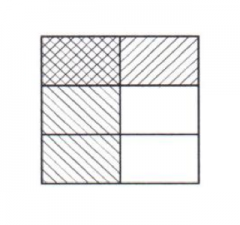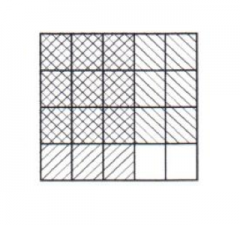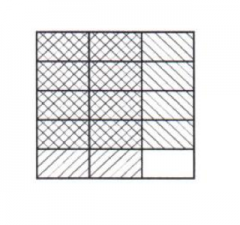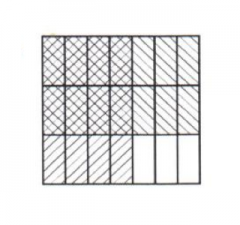![]()
![]()
![]()
Use LEFT and RIGHT arrow keys to navigate between flashcards;
Use UP and DOWN arrow keys to flip the card;
H to show hint;
A reads text to speech;
31 Cards in this Set
- Front
- Back
|
3/4 can be thought of as "three fourths" or as _______ divided by _______. |
3/4 can be thought of as "three fourths" of as three divided by four.
|
|
|
Write the fraction as a mixed number 33/6
|
5 3/6 or 5 1/2
|
|
|
Write the fraction as a whole number 24/8
|
3
|
|
|
Write the mixed number as an improper fraction. 3 5/8
|
29/8
|
|
|
Write the fraction in simplest form. 24/120
|
1/5
|
|
|
9/27 can be thought of as "nine twenty-sevenths" or as _______ divided by ________. This fraction can also be expressed in simplest form as ____/_____.
|
9/27 can be thought of as "nine twenty-sevenths" or as nine divided by twenty seven. This can also be expressed in simplest form as 1/3.
|
|
|
Mary and I have 9 cookies to share. If we share the cookies evenly, how many cookies will we each get? Solve this problem using a picture.
|
You will each get 4 1/2 cookies. (Picture shows 9 cookies put into two groups of four with the one remaining cookie split in half so each group ends up with four and one half cookies.
|
|
|
There are twenty students in my class, but the pizza we ordered only has 15 slices. If each student gets an even share of the pizza, what fraction of a slice will they get? Use an equation to solve this problem.
|
15 ÷ 20 = ? 15 ÷ 20 = 15/20 = (15÷5)/(20÷5)= 3/4 each student gets 3/4 slice of pizza
|
|
|
Create and solve a story problem to show the equation (2/3) x 4 = ?
|
(2/3) x 4 = 8/3 (word problem that shows four times two thirds of any whole is acceptable and student may also use the relationship (a/b) x c = (ac/b) to solve the equation.)
|
|
|
Create and solve a story problem to show the equation (2/3) x (4/5) = ?
|
(2/3) x (4/5) = (8/15) (word problem that shows two thirds of a whole times four fifths of the same whole is acceptable and student may also use the relationship (a/b) x (c/d) = (ac/bd) to solve this problem.)
|
|

What multiplication problem is shown by this picture?
|
1/2 x 1/3 = 1/6
|
|

What multiplication problem is shown by this picture?
|
3/5 x 3/4 = 9/20
|
|

What multiplication problem is shown by this picture?
|
2/3 x 4/5 = 6/15
|
|

What multiplication problem is shown by this picture?
|
1/4 x 2/5 = 2/20 or 1/10
|
|
|
Use the area formula (L x W = A) to find the area of a rectangle whose sides are 1/2 ft and 3/4 ft.
|
L x W = A (1/2 ft) x (3/4 ft) = 3/8 square ft
|
|

Solve using an area model. 4/7 x 2/3 = ?
|
4/7 x 2/3 = 8/21
|
|
|
20 is how times as many as 10?
|
20 is two times as many as 10.
|
|
|
When you multiply by any fraction that has a value greater than 1, the product will be (greater than, less than) the original number.
|
When you multiply by any fraction that has a value greater than 1, the product will be greater than the original number.
|
|
|
When you multiply by any fraction that has a value greater than 1, the product will be greater than the original number. Why is this true?
|
Any whole number times another whole number greater than one will have a product that is greater than the original number, so the same must be true for fractional values greater than one.
|
|
|
When you multiply by any fraction that has a value less than 1, the product will be (greater than, less than) the original number.
|
When you multiply by any fraction that has a value less than 1, the product will be less than the original number.
|
|
|
When you multiply by any fraction that has a value less than 1, the product will be less than the original number. Why is this true?
|
Any whole number times 0 will always have a product of 0, which is less than the original number. Any number times 1 will have a product of the starting number. Any number times a fraction whose value is between zero and one will have a value between 0 and the value of the starting number.
|
|
|
When you multiply any fraction by 1, the product will always be what?
|
When you multiply any fraction by 1, the product will always be equal to the original fraction.
|
|
|
Show 1 x (a/b) using an equivalent fractions model.
|
(a/b) = (1xa)/(1xb)
|
|
|
Terrance wants to figure out how much money he will be making at his new job. He will make $25 per hour for 37 1/2 hours each week. How much money will Terrance make per week? Use a picture to solve this problem.
|
25 x 37 1/2 = 937 1/2 Terrance will make $937.50 each week. Picture shows 25 dollars in 37 groups, with another group of 25/2 or 12 1/2 dollars.
|
|
|
Sandra plans to swim a total of 2 5/6 miles every week for 2 1/7 weeks. How much is she planning to swim altogether? Use an equation solve this problem.
|
2 5/6 x 2 1/7 = 6 1/14 miles (or 6 3/42 miles)
|
|
|
Create and solve a story problem for 1/3 ÷ 4 = ? Explain how you found your answer.
|
1/3 ÷ 4 = 1/12 Any word problem that shows this is acceptable. Explanation should state that answer was found using picture, equation, or the relationship between multiplication and division so that 1/12 x 4 = 1/3
|
|
|
Create and solve a story problem for 4 ÷1/5 = ? Explain how you found your answer.
|
4 ÷ 1/5 = 20 Any Word problem that shows this acceptable. Explanation should state that answer was found using a picture, equation, or the relationship between multiplication and division so that 20 = 4 x 1/5
|
|
|
A father took a bit of a candy bar that left 3/5 of the bar for his children. He split the remaining amount between his two children. What fraction of the entire candy bar did each child receive? use a problem to solve this problem.
|
Each child gets 3/10 of the candy bar. Picture shows 3/5 of a candy bar split into 2 equal pieces which each represent 3/10 of the candy bar.
|
|
|
Diana practices the piano for 3 hours each week. She practices 1/2 an hour on each of the days that she practices. How many days does Diana practice each week? Use a picture to solve this problem.
|
Diana practices 6 days a week. Picture shows 1/2 hour of practice each day starting with one day of the week and stopping 6 days later when 3 hours has been reached. |
|
|
Sam has 5 yards of ribbon. She wants to cut the ribbon into pieces that are each 1/4 yd long. How many pieces of ribbon will Sam have? Use an equation to solve this problem.
|
5 ÷1/4 = 20 Sam will have 20 pieces of ribbon.
|
|
|
There are 4 gallons of milk. How many 1/2 gallons of milk are there? Use an equation to solve this problem.
|
4 ÷ 1/2 = 8 There are 8 half gallons of milk.
|

